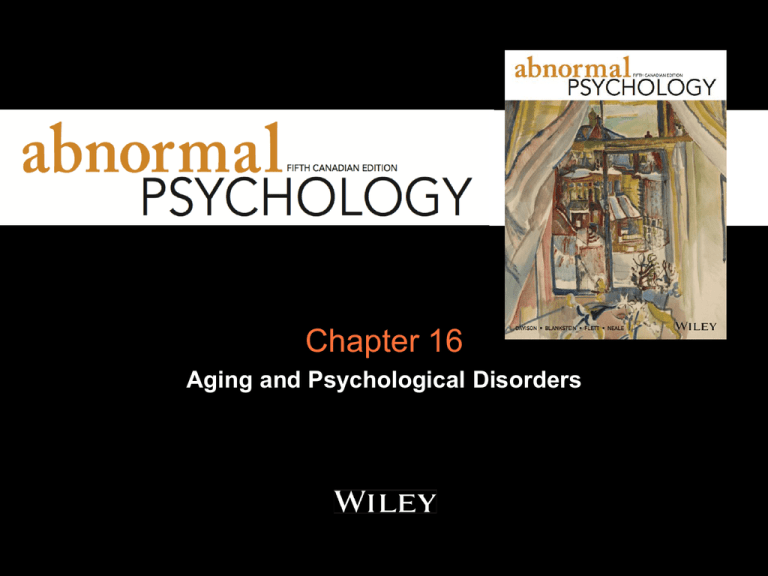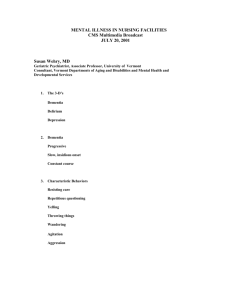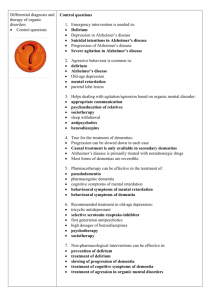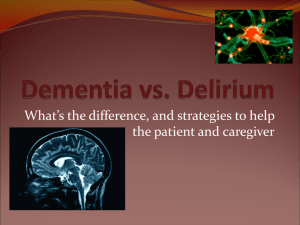
Chapter 16
Aging and Psychological Disorders
Chapter Outline
•
•
•
•
Issues, concepts, and methods in the study of
older adults, old age, and brain disorders
Old age and psychological disorders
Treatment and care of older adults
Issues specific to therapy with older adults
Facts About Aging Population
•
•
•
65 years old and older:
•
•
•
Young-old: 65-74
Old-old: 75-84
Oldest-old: 85 and over
Changing demographics in Canada
•
•
•
•
In 1998, 3.7 million (12.3%) of population were 65 and over
In 2011, over 5 million (14.8%) of Canadians
In 2041, expectation are 10 million Canadians
In 2015, more senior citizens than children
In 2050, 1 in 5 people in the world will be 60 and older
Issues, Concepts and Methods in the
Study of Older Adults
Dementia
•
•
•
•
Dementia— term for gradual deterioration of
intellectual abilities to the point that social and
occupational functions are impaired
Course may be progressive, static, or remitting
Prevalence of dementia with advancing age
•
•
13.9% in people aged 71 and older
37.4% in people aged 90 and older
Incidence of cognitive impairment without
dementia occurs in 22.2% of people age 71 or
older
Symptoms of Dementia
• Difficulty remembering things
• Especially recent events
• Leaving tasks unfinished
• Hygiene may be poor and appearance sloppy
• Getting lost
• Difficulty comprehending making plans or decisions
• Poor impulse control
• May use coarse language, tell inappropriate jokes, or shoplift
• Deterioration of abstract ideas, make faulty judgments
• Disturbances in emotions, including outbursts,
depression
Classification of Dementias
•
•
•
Alzheimer’s Disease
Frontal-temporal Dementias
Frontal-subcortical Dementias
Alzheimer’s Disease (AD)
•
•
•
•
•
Described by German neurologist Alois Alzheimer
(1906)
Accounts for about 50% of dementia in older people
•
•
•
Prevalence in Canada: 1.5% of population (2010)
Estimated prevalence 2.8% of population (2038)
1/13 Canadians over age 65 has AD or related dementia
Death usually occurs 10 or 12 years after onset
Although women live longer, more die as a result of AD
than men
Promoting mental and physical exercise could reduce
risks by 10%
Alzheimer’s Disease (cont.)
Main neurological changes:
•
•
•
•
Atrophy of cerebral cortex
•
•
•
Begins with entorhinal cortex and hippocampus,
then frontal, temporal, and parietal lobes
As neurons and synapses are lost, fissures widen and
ridges become narrower and flatter
Ventricles also become enlarged
Plaques— small, round areas comprising remnants of
lost neurons and b-amyloid are scattered throughout
cortex
Neurofibrillary tangles— tangled, abnormal protein
filaments accumulate within cell bodies of neurons
Plaques and tangles are present throughout cerebral
cortex and hippocampus
Alzheimer’s Disease (cont.)
Causes of Alzheimer’s Disease
•
Genetics – strong evidence
•
Environmental role
•
•
Risk first-degree relatives of afflicted individuals
Concordance for MZ twins is greater than for DZ
twins
•
•
‘Use it or lose it’
Research shows:
•
•
•
Engaging in cognitive activities helps to preserve
intellectual functioning
Cognitive activity preserves crystallized intelligence more
than fluid intelligence (new learning)
Cognitive reserve hypothesis that high education levels
help to delay onset of dementia
Frontal-Temporal Dementias
•
•
•
•
•
Accounts for 10 to 15% of cases
Typical age of onset is late fifties
Marked by extreme behavioural and personality
changes
Not closely linked to loss of cholinergic neurons
Pick’s disease is one cause of frontal-temporal
dementia
•
Degenerative disorder where spherical inclusions (known
as Pick bodies) are present in neurons
Frontal-Subcortical Dementias
Types include:
Huntington’s chorea —caused by single dominant
gene located on chromosome 4
•
•
•
•
Major behavioural feature presence of writhing (choreiform)
movements
Parkinson’s disease — marked by muscle tremors,
muscularrigidity, and akinesia
•
an inability to initiate movement
Vascular dementia — diagnosed when patient with
dementia has neurological signs or when brain scans
show evidence of cerebrovascular disease
Other Causes of Dementia
•
•
•
•
Infectious diseases
•
•
•
Encephalitis
Meningitis
Syphilis (Treponema pallidum)
Head traumas
Brain tumours
Nutritional
deficiencies
•
Especially of Bcomplex vitamins
•
•
•
Kidney or liver failure
Endocrine-gland
problems
•
Hyperthyroidism
Exposure to toxins
•
•
Lead or mercury
Chronic drug and
alcohol use
Treatment of Dementias
•
Biological Treatments of Alzheimer’s Disease
•
•
•
Involves death of brain cells that secrete acetylcholine
thus try to levels
Blocking creation of amyloid from its precursor protein
Antioxidants (vitamin E) may be useful in slowing
progression
Treatment of Dementias (cont.)
•
•
Psychosocial Treatments for Patients
•
Supportive psychotherapy aiming at minimizing the
disruption caused by the person’s behavioural changes
Many individuals with dementias are supported
by family members
•
Ratio of individuals with dementia living with family in
the community versus in institutions 2:1
Treatment of Dementias (cont.)
•
•
•
Caregiver burden – four kinds identified:
•
•
•
•
Emotional
Physical
Financial
Employment
Caregivers more likely to experience chronic health
problems
Resources available to caregivers
•
•
•
On-line forum
Support groups
Respite from caregiving (health care workers take over from
family for periods)
Delirium
•
•
•
Delirium— “a clouded state of consciousness”
•
•
•
•
•
•
Trouble concentrating and focusing attention
Cannot maintain coherent thought
Early stages— person frequently restless especially at night
Perceptual disturbances
Memory impairment
Paranoid delusions in 40 to 70%
severe delirium
•
•
Speech is rambling and incoherent
Person is bewildered and confused
Difference between delirium and other conditions
•
People with delirium have lucid intervals, show fluctuations in
mental state over the course of the day
Dementia vs. Delirium
Causes and Treatment of Delirium
Causes
•
•
•
Drug intoxications
Drug-withdrawal
reactions
Metabolic and nutritional
imbalances
•
•
•
•
Uncontrolled diabetes
and thyroid dysfunction
Infections or fevers
Neurological disorders
Stress
Treatment
•
If syndrome identified
correctly and underlying
cause promptly treated
•
•
•
1-4 weeks for condition
to clear
If underlying cause not
treated
•
•
Permanent brain
damage
Death
Intervention addresses
risk factors
•
•
•
•
•
Sleep deprivation,
Immobility
Dehydration
Visual and hearing
impairment
Cognitive impairment
Old Age and Psychological Disorders
•
•
•
Rates of mental disorders are lowest in age 65
and older, most are free from serious
psychopathology
Instead, cognitive impairments are more
common
•
5.5% of older men and 4.7% of older women
About 10 – 20% of older adults have
psychological problems serious enough to need
professional help
Depression
•
•
•
•
Depression is less prevalent in older adults than
younger people
In Canada (2005):
•
•
2.6% with major depression
4.9% with minor depression (2-4 symptoms)
Late onset depression (first episode in old age)
Causes of depression:
•
•
•
•
Less involvement in daily activity
Depression maintained by self-critical thoughts
Is related to medical illness
Bereavement
Treatment of Depression
•
•
•
•
Depression is under-treated in the elderly
Cognitive, behavioural, interpersonal and brief
psychodynamic approaches have been used
Quality of client-therapist alliance is a key
predictor of therapeutic response
Reminiscence therapy can be effective
•
•
•
•
‘life review therapy’
reflect on past experiences
re-examine events
Example: perfectionists who are pre-occupied with past
mistakes work on less self-critical interpretations of
their experiences
Anxiety Disorders
•
•
•
•
•
Anxiety more prevalent than depression
Less prevalent in older people than younger adults; about
7% of people 65 and older
Risk factors: e.g., being female, having several chronic
medical conditions, not being married, low levels of
education
Can complicate other conditions
Most prevalent: GAD and agoraphobia
Substance-Related Disorders
•
•
Alcohol use and dependence
•
•
•
•
In Canada: 8.9% had definite alcohol abuse; 3.7% had
questionable alcohol abuse
In US: 10.8% of elderly men; 2.9% in elderly women
In England: 28.6% in elderly men; 10.3% in women
Heavy drinking is linked to depression, anxiety, health problems
Medication misuse
•
•
•
Much greater problem than drug and alcohol abuse
Elderly are 13% of population but they consume 33% of all
prescribed meds
Problem: Obtain prescriptions from several doctors
Sleep Disorders
•
•
•
Insomnia:
•
•
•
•
Common problem: 1 in 5 older adults (65-79)
More frequent, less severe than in younger populations
with more complications
Less night-time sleep, more daytime naps, more nighttime interruptions, less time in REM sleep
More sleep disturbance in older men than in older
women
Causes of sleep disorders:
•
Medication, anxiety, depression, lack of activity, poor
sleep habits, sleep apnea
Treatment of sleep disorders
•
Pharmacotherapy, possible over-use in nursing homes
Suicide
•
•
•
•
•
•
•
Prevalence: 3x higher than in younger adults
Peak ages for suicide: 80-84 in white US men
Older adults are less likely to communicate their intention
than younger adults
Ratio between attempted and completed suicide are
much higher in older adults (4:1) compared with 8:1 in
overall population
Causes of suicide: loneliness, poor cognitive functioning,
general and interpersonal hopelessness
Link between health problems, depression and suicide
Alcohol use associated with more violent methods
Treatment & Care of Older Adults
•
•
•
Nursing Homes
Alternative Living
Settings
Community-Based
Home Care
•
Considerations in
Therapy:
•
•
•
•
Social context
Loneliness
Physical frailty
Death and dying
Treatment and Care of Older Adults
APA Practice Guidelines
Copyright
•
Copyright © 2014 John Wiley & Sons Canada, Ltd. All rights
reserved. Reproduction or translation of this work beyond that
permitted by Access Copyright (The Canadian Copyright
Licensing Agency) is unlawful. Requests for further information
should be addressed to the Permissions Department, John
Wiley & Sons Canada, Ltd. The purchaser may make back-up
copies for his or her own use only and not for distribution or
resale. The author and the publisher assume no responsibility
for errors, omissions, or damages caused by the use of these
programs or from the use of the information contained herein.






